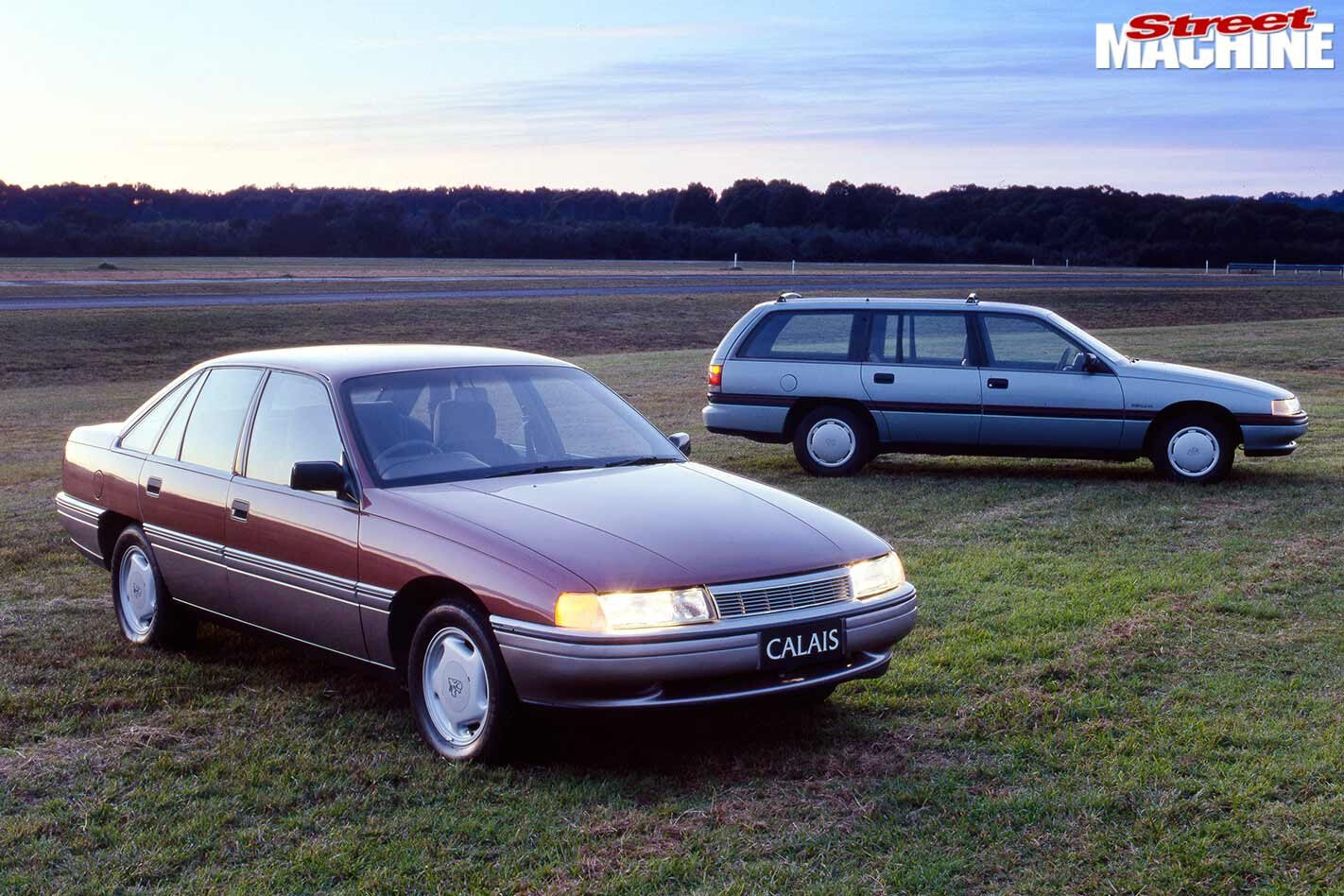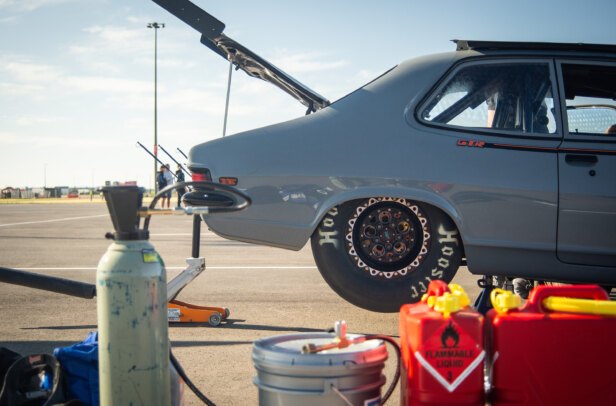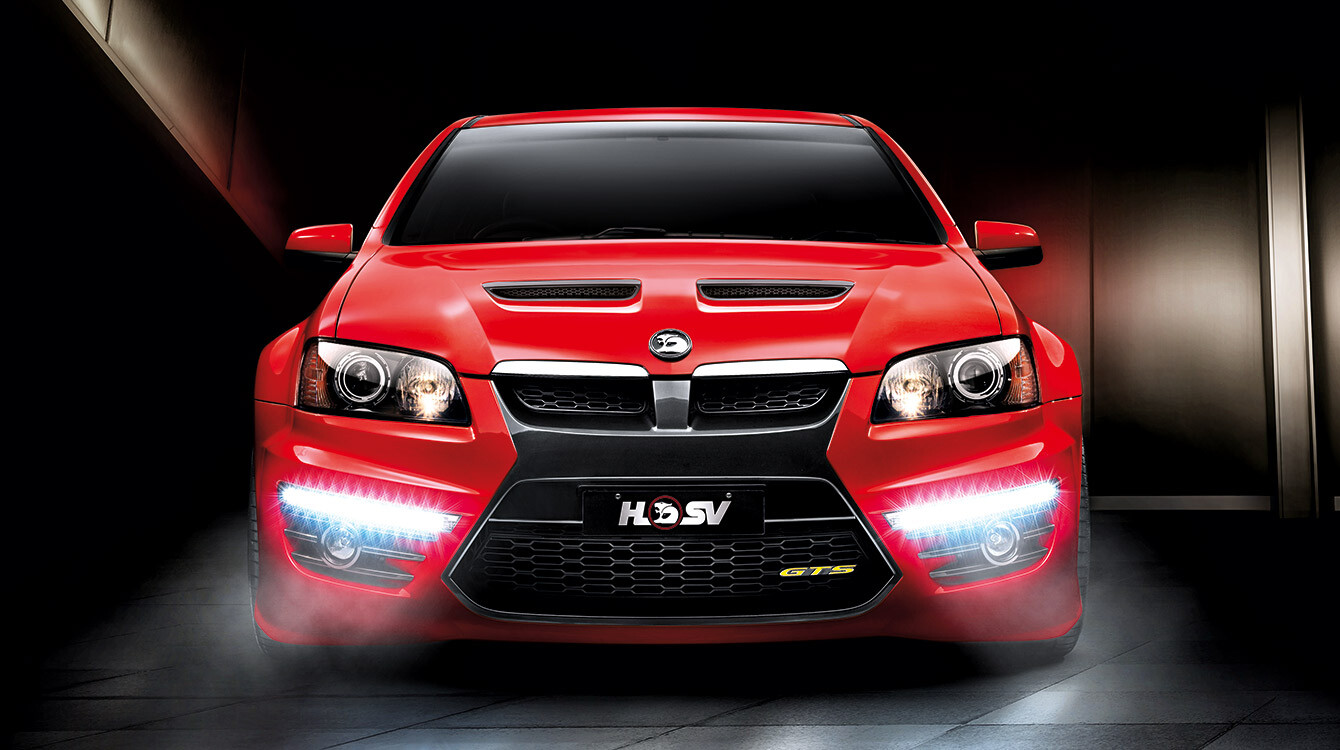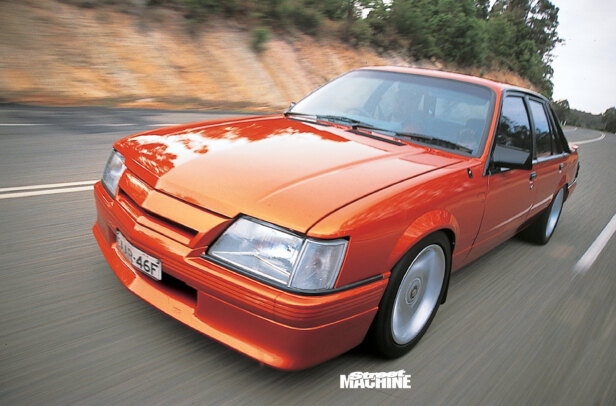LAST time, we took you on a journey through Holden’s rocky transition from producer of ‘Australia’s Own’ car to GM global team player. We tracked the Commodore’s shift from its Opel roots as Holden’s engineers corrected suspension, steering and interior issues not apparent overseas. The Aussies steeled the Commodore for local conditions, adapted it to accept Holden’s big, boofy drivelines and, model by model, tailored it to our tastes.
Sales-wise, it’s true Holden played catch-up during the first Commodore’s production run; the company’s gamble on the V-platform ‘world car’ was born of escalating fuel prices, a crisis that dissipated the moment the small Commodore appeared. Ford’s similar yet opposite wager paid off, the full-sized ‘Blackwood’ Falcon almost immediately toppling Holden from the peak of the sales charts.
It’s telling that Holden blasted out five different models (VB/VC/VH/VK/VL) across the Commodore’s first generation to the Falcon’s three (XD/XE/XF), with the local GM arm left smarting to the tune of $700 million in losses. But for all the updates made to differentiate the Commodore from its German heritage, the one thing Holden could not address was the most important: space.
As early as 1981, the boys in the backroom knew that the next-gen Commodore had to be bigger in order to regain lost fleet, taxi and police sales and put Holden back on an even footing with Ford. But could they afford it?
Holden VN Commodore
Chuck Chapman, then Holden’s managing director, understood that a true Falcon competitor would need a massive investment from General Motors, something far from guaranteed given the losses of the previous decade.
With Opel working on a high-tech, aerodynamic replacement for the Rekord and luxury Senator, Holden looked again to leverage off its German cousin. Things were promising, with the new Opel twins, Omega and Senator, resting on a big 2730mm wheelbase – up some 62mm on the previous generation. Nevertheless, the lack of width remained a problem.
Chuck Chapman, Holden’s MD during the tumultuous days of the early Commodore, retired on 31 December 1987, the VN project all but complete. Overseas influences had forced Chapman into accepting the original smaller Commodore, and he rallied unsuccessfully against cancelling the WB Kingswood, but he got Holden back on top with the VN, then dropped the mic
Holden brass attempted to influence Opel into creating an Omega wide enough for everyone to share, but it was not to be. In October 1982, the boffins in Germany informed Holden that any further increase in girth would negatively affect aerodynamics, something they were not willing to concede.
Around the same time, Ray Grigg, Holden’s director of planning, laid out four directions for the new Commodore to the company’s strategic planning committee, the most costly of which was to splice the Opel down the guts and plonk it on a widened VL floorpan.
Executives at the meeting were acutely aware this would create an enormous amount of work and expense, but equally, set the company’s course and profitability for years to come. Yet despite a swift schooling by fleet managers and the buying public, Chapman still needed convincing that the new Opel Omega wouldn’t work here as it was.
The planning department’s Roger Gibbs worked with design staff to sway the Holden boss; in March 1984, they sat Chapman in an adjustable seating buck, along with a procession of Holden executives, and set the structure to mimic the proposed widths of the Opel and the wider Commodore. Still to be convinced, he countered: “This is static; you’d get a different impression of size if you were moving.” After all, it would be his buck-testing arse that would have to beg for GM’s money.
Cue an 80s montage and the purchase of one XE Falcon, cut, shut and restructured to replicate the proposed interior dimensions of the new Commodore, then loaded with said executives for a thorough back-seat road-test. This also included a standard Falcon and current, 80mm-skinnier VK Commodore for good measure.
Following the test, the decision was unanimous: Chuck would take the proposal for a wider Commodore to GM. Not only that, it needed to be wider than originally planned! If GM would pony up the cash for 80mm, then 90mm would cost no more, ensuring the new Commodore’s header rails sat a sufficient distance from the rear passengers’ eyes. The final proposal was nearly 100mm wider than the outgoing VL and, unbeknownst at the time, 3mm wider than the forthcoming EA Falcon.
On 23 January 1985, Chuck Chapman and Ray Grigg gave a 15-minute presentation to GM heavies at the Warren Tech Centre in Detroit to convince them of the idea. They were granted $200 million for the new Commodore, $50 million of which would go towards creating the new car’s desperately needed increased width. So how to build a Falcon-sized car starting with an Opel-sized butt?
Phil Zmood and his design team had free reign, but for cost reasons still referred back to the Opel twins where possible, especially for the trick flush glasshouse. The Senator donated doors and roof, while the Omega offered a template for rear quarters, albeit with some revisions. At the pointy end, the Opel’s slippery but controversial frontal area was also up for review. The German car’s drag coefficient was 0.28, making it the most aerodynamic sedan in the world at the time, but Chapman knew that Aussies cared about width more than wind! Zmood’s altered frontal treatment also had to hide the new Commodore’s VB-VL chassis origins; 19mm extra grafted to each sill did not translate to suspension geometry and there wasn’t enough cash to widen it to match. Zmood’s solution was a masterstroke. By ditching traditional integrated wheelarch flares, the car could sit comfortably over the narrow VL’s 1451mm front end and blend subtly outwards to meet the wider body, leading to a 1478mm rear track, up 45mm on the previous model.
Releasing Holden’s designers from the constraints of the Omega’s major datum points meant the pitch for a long-wheelbase wagon, with costs to be shared across a long-wheelbase luxury sedan and ute, was relatively easy. The consensus within Holden was that the Omega’s wagon variant was too boxy, and when combined with the longer wheelbase became positively hearse-like. “We restyled the wagon completely; we still have a massive rear cargo area, but we also have a total vehicle rather than a sedan with a box on the back,” Phil Zmood said at the time.
While stylists were busy revising the Opel shape to suit Holden’s underpinnings, drivetrain engineers were sweating over the engine. With the deal to purchase Nissan’s RB30E motor for the still-upcoming VL signed in 1983, the silky-smooth six was the obvious choice; furthermore, Nissan Australia was keen to build the motor locally as a 3.3-litre, but needed Holden’s long-term commitment to seal the deal.
In previous Holden models, dashboards, gauges, heater units and other controls were installed by patient and flexible workers. For the VN, new construction techniques saw ‘cockpit assemblies’ put together off-line, attached to the steering column and pedal box, then chucked through the front windscreen aperture as a single unit
It was the marketing department, rather than the engineers, that saw a problem: The big, new Commodore needed a big engine to suit, and the Nissan’s capacity simply didn’t look butch enough on paper to match the Falcon.
With time ticking away and no serious alternatives to the RB30E locked in by mid-1986, Chuck Chapman and Don Wylie, director of engineering and design, flew to Detroit to check on the progress of Buick’s 3.8-litre V6, an engine previously dismissed for the VL as being too raucous! Testing it against a spanking-new, RB30E-powered VL Commodore specially flown to Detroit, the boys were impressed with the motor’s newfound refinement and approved it for fitment for the upcoming VN, backed by a four-speed auto and five-speed manual. Knowing the new Commodore was only two years away, they hedged their bets, not cancelling the RB30E-powered project until mid-1987 when they could be sure the V6 was on track for a 1988 release.
Opel door trims were not used for cost reasons; nevertheless, the VN contained the first moulded door trims after decades of Masonite boards, while the headlining was the first moulded design in a Holden
While the path of Holden’s mainstream six was fairly convoluted, the development of the V8 was far more linear. Decimated fleet sales aside, the smaller Commodore had forged a considerable reputation as the sportier alternative against the big Falcon, especially after Ford officially cancelled their V8 option in late 1982.
Buoyed by the Commodore’s successes on the race track and Street Machine’s own emotive ‘V8 ’Til ’98’ campaign launched in 1984, the 5.0-litre was officially green-lit in mid-1986.
Launching in early 1989, the VN V8 ran new heads, inlet manifold, exhaust manifolds, camshaft and more internal stiffening ribs to eliminate bore distortion. The big news was the port fuel injection controlled by a Delco engine management system. All up, it returned 165kW; not much by today’s standards, but enough to propel the new Commodore to 100km/h in the low sixes. Optional across the range and standard on the new Commodore SS, it forced Ford to rethink its lack of a V8 programme.
So was the VN Commodore just a regurgitated Opel? Doors aside, not really, and even less so than its predecessors. Six years, 19 prototypes, 150 pilot production cars and hundreds of stylists, engineers and line workers point to it being a true Holden.
A BIG DEAL
The VN Commodore was an imperfect car; it used new Opel doors on a previous-gen Opel chassis, albeit one that had received 10 years of local development. Niggling quality issues would have been damning had the EA Falcon, released some months earlier, not suffered rampant quality issues of its own.
Opel returned to recirculating-ball steering after running rack-and-pinion in the earlier V-platform cars at Holden’s insistence. The VN Commodore continued the R&P set-up rather than the inferior Opel design
Yet despite its tumultuous creation, the VN’s styling was a cohesive blend of European and Australian influences, the driveline a mixture of Yank and Australian, while the interior was utterly local.
The VN Commodore won Wheels Car Of The Year in 1988 and returned Holden an operating profit of $157.3 million in 1989 alone. It begat a long-wheelbase luxury sedan, ute and three subsequent update models, each packing an ever-increasing level of tech while simultaneously addressing quality.
The VN’s introduction coincided with a full line upgrade at Holden’s Elizabeth plant, including Japanese-style Kanban or ‘just-in-time’ parts supply. A $200 million investment in the plant included two fully automatic transfer presses and new tooling. Producing the VN at both Elizabeth and Dandenong would have added a $200 baseline cost to each vehicle, so Elizabeth therefore shouldered the load alone
So next time you see a thrasher VN Exec chucking a single-pegger during a Today Tonight exposé, spare a thought for the guys that turned a skinny Opel into a phat ride that brought Holden back from the brink.
HOLDEN VN COMMODORE BODY OPTIONS
With a hot cash injection from Detroit far from guaranteed, Holden considered several cheaper, alternative directions for the VN Commodore, including: facelifting the VL (as the VM); plonking the Opel body over the VL platform; or building the Omega on Aussies shores as it was, either with the German driveline intact or using the beloved, Nissan-sourced VL driveline.
Yet none of these options addressed the issue of width. Lateral thinking saw Holden’s planning people also investigate the GM70, a Yankee front-wheel-drive project that would form the basis of the H-body Oldsmobile Delta and Cadillac Seville, among others. The size was fine, but totally re-engineering the car for rear-wheel drive put it out of the running.
Holden also looked at replicating the Pontiac Fiero’s build technique, hanging plastic panels over a space-frame. It would allow a huge array of body styles, but despite the economies of scale determining a favourable break-even point, the Aussie plastics industry was deemed unable to cope with the predicted volumes.
VN COMMODORE ENGINE OPTIONS
Prior to settling on the Buick-derived 3.8-litre V6 for the VN, several other engine options were considered:
- Creating a new, 3.3-litre straight-six based off the successful Family II four-banger
- Dusting off the OHV
- Holden black six and giving it an overhead cam and crossflow head
- Straight-up buying OHC sixes from Ford. This was ultimately cancelled because the Falcon’s tall motor would not fit under the VN’s sloped bonnet – and also because it
was against the constitution to put a Ford motor in a Holden! - Developing a unique, 3.8-litre V6 from Holden’s 5.0-litre V8; a quartet of running motors were prototyped before this project was cancelled
DID YOU KNOW?
• The VN model included the final homologation special built for local touring car racing, but the mighty Commodore SS Group A (above) was not the nastiest V-platform car available. The UK’s Lotus Carlton/Omega (below) packed a 24-valve, 3615cc straight-six, force-fed by a pair of intercooled Garrett T25 turbos running 10lb of boost. It was good for 281kW. Backed by a six-speed manual sourced from the Corvette ZR-1, the diff centre came from our own VN Commodore SS Group A. With a 0-100km/h sprint of just 5.2 seconds and a top speed of 285km/h, performance was on par with the supercars of the day. A ram-raider’s delight, only 950 were built: 320 Carltons and 630 Omegas, all in Imperial Green.
• Holden exported a variant of the Calais, badged as an Opel, in small numbers to Malaysia and Singapore across the VR and VS models. The VR Opel Calais ran a Statesman grille, bonnet and bumper, while the VS upgraded to a Caprice item. Both ran a 2.6-litre Opel straight-six, imported from Germany and installed on the line at Elizabeth.
• The ill-fated UAAI agreement resulted in the Commodore also being sold as the Toyota Lexcen (above) throughout the VN-VS run. Future Holden design boss Richard Ferlazzo handled the Lexcen’s mild restyle during his early days at Toyota, but the V6 auto-only Lexcen convinced few, averaging around 12 per cent of Commodore’s sales. The UAAI agreement was dissolved in 1996 and the Toyotadore discontinued in 1997, but not before a VT-based Lexcen was prototyped, just in case.
- Opel donated Senator doors and modified Omega rear quarters, all grafted to a widened, VL-derived floorpan
- Front styling, rear styling, wagon and interior all 100 per cent locally designed
- 3.8-litre V6 engine fully imported from the USA at first, then assembled with more local content and influence as each upgrade applied
- 5.0-litre V8 re-engineered for multi-point fuel injection and later stroked to 5.7 litres by HSV
- Other names considered: Kingswood (again)
HOLDEN VQ STATESMAN/CAPRICE
Following the death of the HZ Kingswood in 1980, Holden’s beloved chassis soldiered on as the WB in luxury sedan and commercial form only. By 1985, they were gone too, leaving a long-wheelbase-sized hole in Holden’s range.
Although seen as a return to form for Holden, the VQ Statesman and Caprice luxury twins, released in March 1990, were heavily criticised for sharing too many parts with the VN Commodore. As spectacular and un-Opel-like as the unique hidden C-pillar appeared, the front quarters, bonnet, headlights, boot lid and tail-lights were all Commodore – a trap Ford avoided when designing the NA Fairlane and DA LTD, which used only the windscreen and front doors from the EA Falcon.
While the 14-speaker stereo cassette system in the Caprice was pretty speccy, it was the long-awaited introduction of Independent Rear Suspension, a first for an Aussie luxury car, that upset Ford’s apple cart. The VQ and VQII previewed several other mechanical upgrades that would see their way into the 1990 VN Commodore update and 1991 VP range, including Holden’s first local ABS braking system.
Riding high on the success of the VN and VQ, just five months later Holden returned to the lucrative commercial market with the VG. Essentially a VN ute, it reintroduced the column-shift auto with a bucket-bench-bucket seat that would filter back through into taxi-pack sedans and wagons. More importantly, by way of a V8 option, it established the Commodore ute as a performance player. Interestingly, there was no Opel equivalent.
Special editions
- Commodore Vacationer sedan and wagon (VN, VP, VS)
- Commodore LE sedan and wagon (VN)
- Commodore SL* National Police Pack (BT1) sedan and wagon (VN, VP)
- Commodore Executive National Police Pack (BT1) sedan and wagon (VR, VS)
- Commodore SS V6 sedan (VP)
- Commodore Equipe sedan and wagon (VR, VS)
- Commodore iD ute (VS)
- Commodore 50th Anniversary ute (VS)
- Commodore SS ute (VS)
- Commodore Olympic Edition ute (VS)
- Commodore Esteem sedan and wagon (VS)
- Berlina LX sedan and wagon (VP)
- Calais International sedan (VP)
- Statesman International (VS)
- Statesman 50th Anniversary (VS)
* VN and VP Commodore SL were noted in several publications and pictures of SL badges exist; however, it appears all were actually badged Executive despite equipment differences
Holden VP/VR/VS Commodore
Refinement and quality fixes slipped quietly into production during the VN’s lifecycle were heralded as new upgrades with the 1991 introduction of the VP facelift. The VP Commodore was the first to include ABS and IRS – standard on the SS and Calais, but optional across the range. Also fitted to the Calais was Bosch’s Body Control Module system, designed to control speed alert, auto headlights off and the Variatronic power-steering system.
In mid-1993, the VP gave way to the VR, a major re-style and re-engineering project good enough to win Wheels Car Of The Year that year. Holden altered the glasshouse for the first time, taking the design further away from the Opel donor, as did a new nose and tail. Holden stylists reintroduced wheelarch flares over the front and rear guards, made possible as engineers finally addressed the suspension geometry, adding 40mm to the car’s front footprint. The Statesman and Caprice, having forgone a VP-model upgrade in lieu of an official VQ Series II, received all new rear sheet metal for the VR, mimicking the rear styling of the early-90s Oldsmobile Cutlass Supreme.
The visually similar VS of 1995 saw Holden concentrate on engine upgrades for the final model of the second-generation Commodore. The V6 was given a thorough re-engineering and rebranded Ecotec, receiving a new block, heads, manifolds, sump and a sequential EFI system freeing up an extra 17kW, with six per cent greater efficiency.
The L67, a supercharged version fitted with an Eaton blower, appeared as an option with the VSII Calais. Casting an eye to safety, the VR and VS respectively saw Holden introduce driver and passenger airbags to complement the ABS system filtering gradually through the range.
EXPORT COMMODORES
As with the VB-VL series, New Zealand copped its fair share of weird versions, including the VN Commodore Royale, a Calais-spec sedan with a 2.0L Family II four-banger.
The Royale returned to NZ with the VS model; a special batch of 2.5L Opel V6-powered sedans were ordered for export to Singapore, but the job was cancelled after their construction. Not compliant in Australia, they instead were chucked into NZ Royales, sold exclusively through Ebbett Waikato dealers.
EXPORT ENGINES
- Family II 2.0-litre SOHC four-cylinder (VN)
- Opel Dual-Ram 2.6-litre six-cylinder (VP, VR)
- Opel 2.5-litre DOHC V6 (VS)




Comments